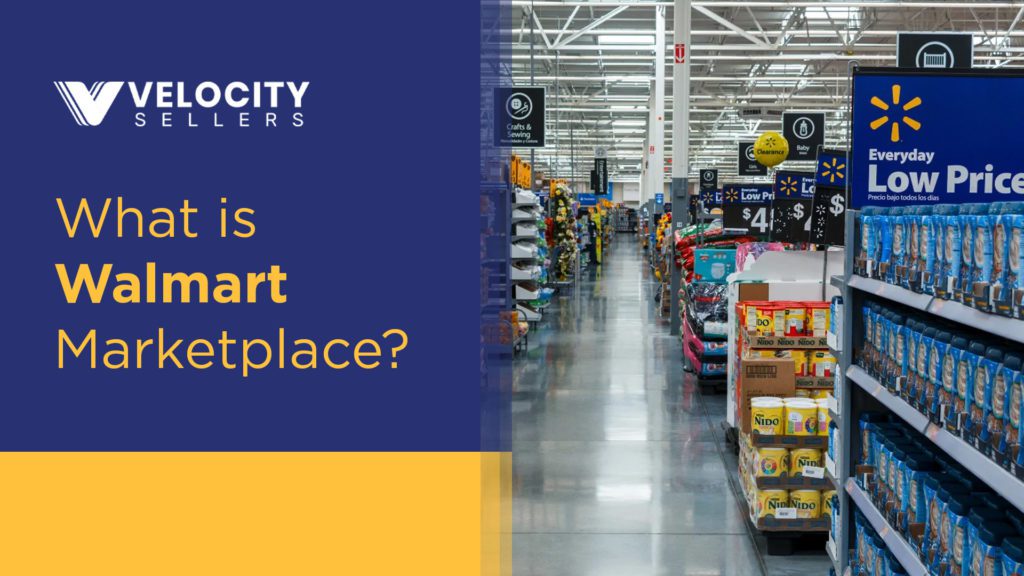These days, customers expect a lot from their shopping experience. It’s time-consuming and inconvenient to find what you’re looking for on one website—and tiresome to navigate between multiple seller sites. With Walmart Marketplace, sellers can build online shops and get a trusted spot on the world’s most popular marketplace. This means more sales, as well as increased exposure to new audiences.
Walmart continues to lead the e-commerce charge, with its Marketplace now boasting more than 150,000 sellers. They also saw triple the gross merchandise volume in 2020 versus the previous year.
As a top-selling global platform, Walmart Marketplace allows sellers to establish their stores and sell their items directly to customers. This eCommerce platform allows you to set up your store, manage inventory, and create compelling content and promotions while improving visibility to shoppers looking for your products.
The Walmart Marketplace platform has been growing exponentially faster than the market leaders (i.e., Amazon and eBay). Since it only accepts US-based sellers, Walmart has a less saturated market. Sellers on the platform have better chances of making more sales.
Thanks to Walmart’s millions of customers, sellers can target a customer base anywhere worldwide. Sellers also have better clarity concerning pricing, availability, stock levels, etc. Since Walmart takes care of operational issues, sellers can focus on their business without worrying about warehousing or shipping.
What is Walmart Marketplace?

Walmart Marketplace allows you to build your brand and expand your business into a large, already-established market. It boasts 400 million monthly customers shopping monthly in different categories. And at Walmart, there are no seller fees to get started and zero monthly or setup fees.
You can sell your products on the platform without the headaches of managing an eCommerce platform, inventory, and logistics. Its omnichannel capabilities let you manage returns and refunds on products, allowing you to focus on growing your business.
Since its inception in 2009, Walmart Marketplace has seen exponential growth at over 400 million unique visits monthly. It’s been taking over Amazon’s market share, which makes it ideal for sellers and brands. Walmart Marketplace offers excellent opportunities, with less expensive fees and more selling tools to help sellers grow their businesses.
Selling on Walmart Marketplace
Walmart has become the number 2 online retailer worldwide, surpassing eBay with enough sales to rank behind only Amazon.com. As people work from home and avoid public places, Walmart’s online sales have increased by 74%. Unlike e-Bay or Amazon, Walmart Marketplace offers a unique set of audiences.
Walmart is an excellent platform for established brands to expand their business. Since it only caters to U.S. sellers, they can be strict in submitting their applications excellently and require an established business history and size before applying. The application process can be challenging, but if you meet the requirements, it can be well worth it. With powerful internal marketing tools, Walmart has the potential to generate a high level of sales, far surpassing those of Amazon. It also has much low competition compared to Amazon.
This makes it easier for sellers, even in more competitive niches, to rank at the top. Amazon is known as a very competitive marketplace with seasoned sellers who make lots of sales.
They also have much higher PPC costs which make it difficult for smaller sellers to compete with larger sellers. As a seller, you can expect to pay Amazon a monthly fee of $39.99 when selling on their online Marketplace. Walmart, however, does not charge sellers a monthly fee. Instead, they only charge referral fees after selling products through the site. This is one of the ways Walmart can offer lower prices than Amazon and remain profitable as an online retailer.
Because of Walmart’s rigid application and selection process, there’s less competition and saturation, allowing you to establish your brand presence. Although Walmart Marketplace offers an excellent platform, it can be tricky for sellers. The e-Commerce platform needs to catch up with Amazon’s fulfillment services. Its warehouses are still far from that of Amazon. Walmart is using its stores to expedite its fulfillment process. They also face inventory issues at their warehouses, which they plan to resolve as they refine their processes.
Large, heavy, or bulky items are currently only carried by Amazon. On the other hand, Walmart is more selective in the goods they stock, and their FBA solutions still need to be fully developed compared to Amazon’s.
Although Walmart has been aggressively trying to win over merchants with its third-party Marketplace, it still needs to provide its sellers with a consistent experience.
How to Start Selling on Walmart Marketplace

Walmart has become the number 2 online retailer worldwide, surpassing eBay with enough sales to rank behind only Amazon.com. As people work from home and avoid public places, Walmart’s online sales have increased by 74%. Unlike e-Bay or Amazon, Walmart Marketplace offers a unique set of audiences.
Walmart is a great platform for established brands to expand their business. Since it only caters to U.S. sellers, they can be strict in how their applications must be submitted and require an established business history and size before applying. The application process can be challenging, but if you meet the requirements, it can be well worth it. With powerful internal marketing tools, Walmart has the potential to generate a high level of sales, far surpassing those of Amazon. It also has much low competition compared to Amazon.
This makes it easier for sellers, even in more competitive niches, to rank at the top. Amazon is known as a very competitive marketplace with seasoned sellers who make lots of sales. They also have much higher PPC costs which make it difficult for smaller sellers to compete with larger sellers. As a seller, you can expect to pay Amazon a monthly fee of $39.99 when selling on their online Marketplace. Walmart, however, does not charge sellers a monthly fee. Instead, they only charge referral fees after selling products through the site. This is one of the ways Walmart can offer lower prices than Amazon and remain profitable as an online retailer.
Because of Walmart’s rigid application and selection process, there’s less competition and saturation, allowing you to establish your brand presence. Although Walmart Marketplace offers an excellent platform, it can be tricky for sellers. The e-Commerce platform needs to catch up with Amazon’s fulfillment services. Its warehouses still need to be closer to that of Amazon. Walmart is using its stores to expedite its fulfillment process. They also face inventory issues at their warehouses, which they plan to resolve as they refine their processes.
Large, heavy, or bulky items are currently only carried by Amazon. On the other hand, Walmart is more selective in the goods they stock, and their FBA solutions still need to be fully developed compared to Amazon’s.
Although Walmart has been aggressively trying to win over merchants with its third-party Marketplace, it still needs to provide its sellers with a consistent experience.
Walmart Marketplace Sellers’ Requirements
With no monthly subscription or setup fees and a low referral fee for sold items, Walmart Marketplace is a great place to expand your business. Selling on Walmart allows you to access millions of unique monthly shoppers.
You need to create a request before selling on Walmart’s Marketplace. This request involves entering information including:
- Business Tax I.D.s/ Business License Numbers (Social Security Numbers are not allowed)
- Supporting documents to verify your U.S. business name and address (These documents can be W9, W8, and EIN Verification Letter from the Department of Treasury)
- E-commerce or marketplace success history
- Integration method for your product catalog
- A catalog without products from Walmart’s Prohibited Products Policy
- Fulfillment through Walmart Fulfillment Services (WFS) or another B2C U.S. warehouse with returns capability
- Products with GTIN/UPC GS1 Company Prefix Numbers
Prepare this information before sending a request to save time with your application/request. With the right information, you may be approved in as fast as two weeks. Approval wait times depend on your business size and capabilities, but many sellers get a response in as few as two weeks. To check your application status, visit Walmart’s application status tracker. Provide your email address and tax classification numbers, then click Get Application Status. Walmart will immediately send a general description of the current stage of your application.
Creating Listings and Products on Walmart Marketplace
You’re almost ready to sell on Walmart Marketplace! Before you get started, you’ll need to create a seller account. This is the same account you used to apply for the Marketplace. Visit the Marketplace signup page, fill out the required information, review the terms, and create your Walmart Marketplace account. Walmart has partnered with Payoneer (Payoneer.com) and Hyperwallet (Hyperwallet.com). You can select either as your method for receiving payment for all sales. Once you’re verified, you can start selling. Set the products you want to sell, the pricing and shipping options, and even choose whether or not you wish to offer returns. Then it’s time to get paid. When your customers make a purchase, their payment will be processed through your Walmart Seller Account.
Understanding Shipping Requirements for Walmart Marketplace
Walmart has several shipping options for sellers, ranging from free value shipping to freight. Sellers can use one of Walmart’s approved fulfillment partners or WFS to process and ship their orders, but it is recommended to use the fastest option possible to receive better reviews and improve search rankings.
You can explore various possibilities when configuring your shipping settings and choose what is best for your business. You can take advantage of the 2-day delivery with eye-catching ‘free 2-day delivery’ tags on Walmart.com. These attract attention, increase Buy Box wins, and drive more sales. According to Walmart data, sellers participating in the two-day program might see an average 50% organic lift in conversion. While you can only include free 2-day shipping on some items, you can make that faster delivery promise an opportunity to set your products apart by adding more value and boosting sales. Data shows that 3-day shipping lifts conversion by 30% when selling through the Walmart marketplace.
With no monthly subscription or setup fees and a low referral fee for sold items, Walmart Marketplace is a great place to expand your business. Selling on Walmart allows you to access millions of unique monthly shoppers.
Walmart Marketplace Fees
Marketplace referral fees are paid to Walmart by sellers who use the Marketplace to sell their products. There is no annual, product listing, or monthly subscription fee. Instead, Walmart charges sellers a “referral fee” for each item sold. Referral fees range from 6% – 15% of a product’s gross sales proceeds. The exact percentage depends on the seller’s product category.
Unlike Amazon, you don’t have to pay for setup or monthly fees in Walmart Marketplace. Amazon charges their sellers $39 a month. Walmart has moved to charge sellers monthly storage fees and per-item fulfillment fees. They have a great new product called Walmart Fulfilment Services, which is free but isn’t available to all sellers and only benefits existing marketplace sellers.
Calculating your Walmart referral fee and determining the costs of fulfilling the order are two important aspects of selling on the Marketplace. Since fulfillment is a seller-assumed responsibility and not provided by Walmart, it is essential to understand how fees are generated before doing business with Walmart Marketplace.
Is Selling on Walmart Marketplace Worth it?

Offering millions of unique visitors every month, Walmart Marketplace connects sellers to a massive segment of online shoppers via the Walmart.com website, allowing their products to find new audiences and buyers. Due to its rigid requirements, the competition isn’t as fierce as in Amazon. Sellers can set up their Marketplace store on Walmart.com and sell their products to millions of customers with ZERO monthly or setup fees.
However, their EDLP (Everyday Low Pricing) policy can affect sellers’ profit margins. Sellers also find some of their products being delisted if Walmart sees their products being offered much cheaper on other platforms. Walmart Marketplace might have seen growth but has yet to resolve its warehousing and inventory issues and listing priorities.
Walmart is catching up with Amazon, thanks to its various programs for sellers on its Marketplace. Selling on Walmart can open up new revenue channels for your business and give you access to its large customer base. Its dominance in retail evens out Amazon’s massive online presence. It has demonstrated that it’s in the game for the long haul, and many eagerly wait for it to gain even more momentum.
Amazon and eBay are the largest marketplaces in the world, but with all of their competition, it can be difficult for a seller to stand out. An easier option is to sell on Walmart—you still get all the benefits of being on a big platform with fewer competitors. Plus, you can expand your reach and increase revenue without starting from scratch or working extra hard to grow sales.
As one of the largest e-commerce sites, Walmart has a massive audience to sell to. With more than 110 million unique monthly visitors and Walmart’s significant advertising investments to drive more traffic to their site, there are many opportunities to build your brand recognition and access a pool of loyal customers. It is less saturated than Amazon, making it ideal for your brand to stay ahead of the competition.
Walmart Marketplace Partnership
Selling on Walmart.com gives sellers access to the world’s largest retailer, which means millions of customers. Unlike Amazon, Walmart doesn’t charge a monthly fee. Instead, it charges sellers a percentage-based “referral fee” for contract categories. This means you’ll be charged less and can accurately measure the effectiveness of selling on Walmart. Walmart has less competition than Amazon, meaning you have more freedom to sell your products on the site. It may take some time to get your application or request approved, but Walmart is worth it because of the returns that come with selling there. Even if Walmart Marketplace is new to you, the ease of integration is one of the best reasons to sell on this platform. When you sell on Walmart Marketplace, you are not alone in dealing with any issues or difficulties that may arise. Walmart Marketplace wants to entice sellers by providing the best e-commerce analytics and inventory management tools.
Walmart offers sellers the opportunity to make their products accessible to an international audience. The Marketplace will ensure that you can reach as many interested buyers as possible since its online shop is known for its wide range of products from different categories. At Walmart Marketplace, you only pay for what you sell. There are no setup or monthly fees, just a reasonable referral fee per transaction. Although it’s yet to fix its inventory and warehousing problems, its massive growth over the year proved impressive. Its various seller programs and customer-focused approach catch up with Amazon as the leading e-commerce company. You can tap on Walmart’s unique monthly visitors, less saturated market, and straightforward pricing structure. As a seller, you can work to increase your customer’s lifetime value, streamline operations and attract new customers with Walmart Marketplace.
Conclusion
Walmart Marketplace can be a great sales channel to scale up your business. Sellers today need to get creative about diversifying their channel portfolios and taking advantage benefits that come with selling on Walmart Marketplace. With Walmart’s stronghold as a retail giant, your business can leverage a variety of benefits such as brand recognition, established infrastructure, and increased sales and revenue. Walmart’s huge brand and marketing power is something that your business should take advantage of.

